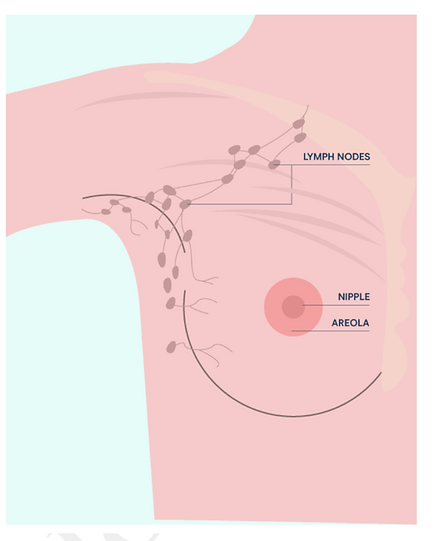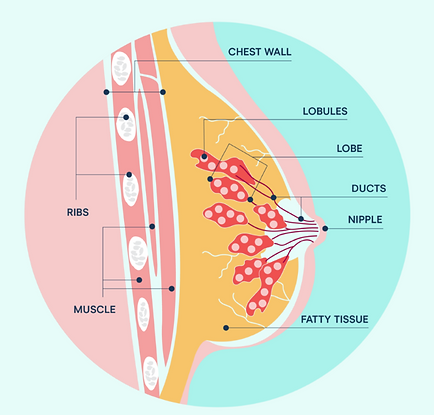Structure of the Breast
The breast is the reproductive organ located on the chest.
The breast differs in shape, color, and texture across different people and changes throughout the menstrual cycle. It is essential to know how your breasts appear and normally feel.

Figure 1: Breast Structure-1

Figure 2: Breast Structure-2
Function of the Breast
The breast’s primary function is to make and deliver milk to feed newborns and infants, and the secondary function is sexual arousal and pleasure.
What is Breast Cancer?
Breast Cancer is a disease caused my uncontrolled growth of breast tissue.
Risk factors for Breast Cancer
Breast cancer starts in the cells of the breast, it can occur commonly in women, but men can get breast cancer.
Specific risk factors of breast cancer include:
- Smoking tobacco
- Aging
- Female sex
- Low consumption of fruits and vegetables
- Excessive consumption of alcohol
- Inherited Genes
- Family history of breast cancer
- Early age of first menstrual period (< 12 years)
- Hormonal Therapy
- Age of first childbirth above 30 years
- Contraceptives such as oral contraceptives, implants, injectibles, intrauterine devices (IUDs), skin patches, vaginal rings
- Lack of exercise
- Breast Implants
Symptoms
Symptoms of breast cancer include:
- New swelling, lump, or bumpy area in the breast or armpit.
- Discharge of fluid from either of the nipples
- Change in nipple position, like pointing in a different direction
- Rash, scaly or itchy skin or redness on breast skin or nipple.
- Change in the size or shape of the breast
- Breast discomfort or pain (a rare symptom of cancer)
Prevention of Breast Cancer
- Breast cancer can be detected early through regular screening tests (tests used to find a disease in people with no symptoms).
- All women must know what to expect when getting a mammogram for breast cancer screening – what the test can and cannot do.
- Women between 40 and 44 may start screening with a mammogram yearly if they have access.
- Women between 45 to 54 years should get mammograms every year.
- Women 55 and older can switch to a mammogram every other year or choose to continue yearly mammograms.
Clinical breast examination (CBE) and Breast Self-Examination (BSE)
Regular physical breast exams done by women (Breast Self-Examination) or health professionals (Clinical Breast-Examination) can help detect breast cancer symptoms. All girls and women should be familiar with the regular appearance of their breasts and look out for changes that were not there before.
Abnormalities to look out for include:
- New swelling, lump, or bumpy area in the breast or armpit.
- Discharge of fluid from either of the nipples
- Change in nipple position, like pointing in a different direction
- Rash, scaly or itchy skin or redness on breast skin or nipple
- Change in the size or shape of the breast
- Breast discomfort or pain (a rare symptom of cancer)
3 STEPS for Brest Self Examination
Step 1: Stand and Look
Begin by looking at your breasts in the mirror.
- First, with your shoulders straight
- With both hands on your waist.
- Raise your arms and look for the same changes
Abnormalities to look out for:
- New swelling, lump, or bumpy area in the breast or armpit.
- Discharge of fluid from either of the nipples (this could be a watery, milky, or yellow fluid or blood).
- Change in nipple position, like pointing in a different direction
- Rash, scaly or itchy skin or redness on breast skin or nipple
- Change in the size or shape of the breast
- Breast discomfort or pain (a rare symptom of cancer)
Step 2: Stand and Feel
- Use your finger pads to examine your breasts.
- Use your right hand to feel your left breast and then your left hand to feel your right breast. Use a firm, smooth touch with your hand’s first few finger pads, keeping the fingers flat and together.
- Use a circular motion and follow a pattern to examine the entire breast.
Step 3: Lie down and Feel
- Lie Down on a flat surface.
- Use your right hand to feel your left breast and then your left hand to feel your right breast. Use a firm, smooth touch with your hand’s first few finger pads, keeping the fingers flat and together.
- Use a circular motion and follow a pattern to examine the entire breast.
Results
If you detect any abnormalities, report them immediately to a doctor.

Figure 3: Performing a BSE
Written and reviewed by
Dr Odiri Oniko (MBBS, GMC-Clinical Fellow)
Dr MaryJane Nweje (MBBS, MSc)
Sources:
- https://www.cancer.org/treatment/understanding-your-diagnosis/what-is-cancer.html
- https://nbcf.org.au/about-breast-cancer/diagnosis/breast-cancer-anatomy/
- https://www.cancer.org/cancer/cancer-causes.html
- https://www.cancer.org/cancer/breast-cancer/about.html
- https://www.breastcancer.org/symptoms/testing/types/self_exam
- https://www.nhs.uk/common-health-questions/womens-health/how-should-i-check-my-breasts/
- https://www.mayoclinic.org/tests-procedures/breast-exam/about/pac-20393237
- https://www.asbestos.com/cancer/breast/

